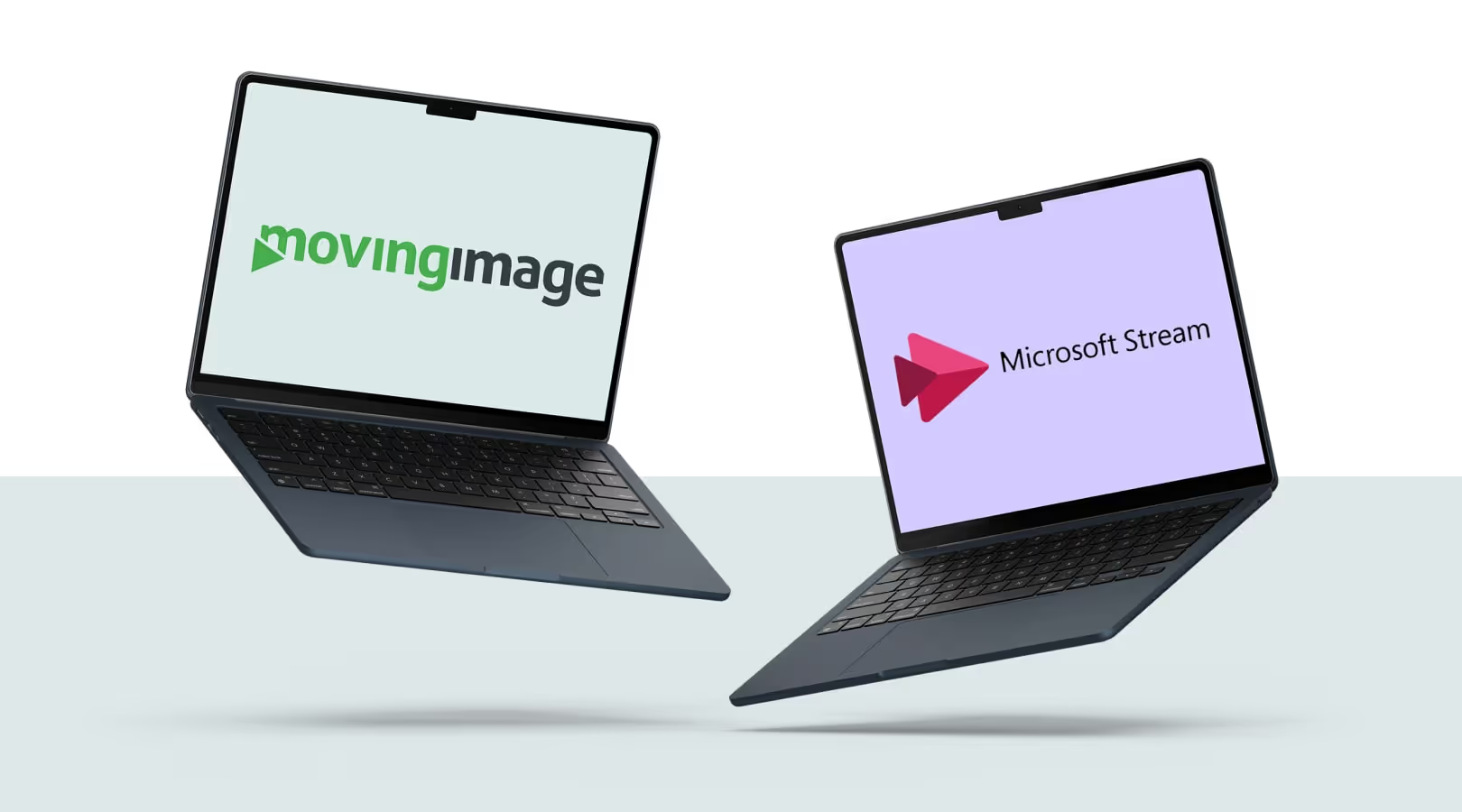14 Video hosting providers: free vs. premium

Driving your success with video

14 Video hosting providers: free vs. premium
How to choose the right video hosting platform
To store videos and make them easily accessible to your audience, uploading them to a video hosting platform is highly recommended. Sure, you could host videos on your own servers and embed them into your website or intranet—but that often leads to issues like network overload, long load times, and frustrated visitors.
A professional video hosting solution saves both you and your viewers from headaches and offers a host of powerful features that go far beyond what traditional embedding can provide.
Modern hosting providers support a wide range of video formats and automatically optimize playback to deliver the best possible video quality—while reducing your network load thanks to a Content Delivery Network (CDN). That’s not to mention built-in tools for SEO and social sharing.
But for companies, other factors come into play: Where are the servers located? What access rights can be granted to viewers and employees? How is the content protected? And how easily can the solution integrate with your existing systems?
To find the right provider, it's crucial to define your use cases and must-haves upfront.
In the next sections, we’ll walk you through the key features of various premium and free platforms.
The best premium video hosting providers
1. VideoManager Pro
Best for: Companies that need secure, centralized, GDPR-compliant video hosting for internal and external communications.

movingimage is the only provider on this list that hosts videos exclusively on servers located in the EU—ensuring full GDPR compliance, even for sensitive data.
As a German company, we understand the unique demands of large enterprises and agencies across the EU. With VideoManager Pro, we offer a powerful Video Content Management System (Video CMS) tailored to these needs, with AI features, RBAC (role-based access control), advanced privacy controls, and more.
One unique feature: you don’t pay for storage space, but for video duration—so you can always publish in the best possible quality without compromise.
Core features include:
- Role-based access control (RBAC)
- Customizable HTML5 video player
- Advanced transcoding
- Video analytics
- Copy protection
- SSL encryption
- IP-range filtering & geo-blocking
- Token authentication
- Auto-captioning
- Custom thumbnails
- Chapter markers
Starter Package includes:
- 500 video minutes (storage + transcoding)
- 500 GB CDN streaming traffic/month
2. Wistia
Best for: Videos that deliver a personalized experience in your marketing funnel.
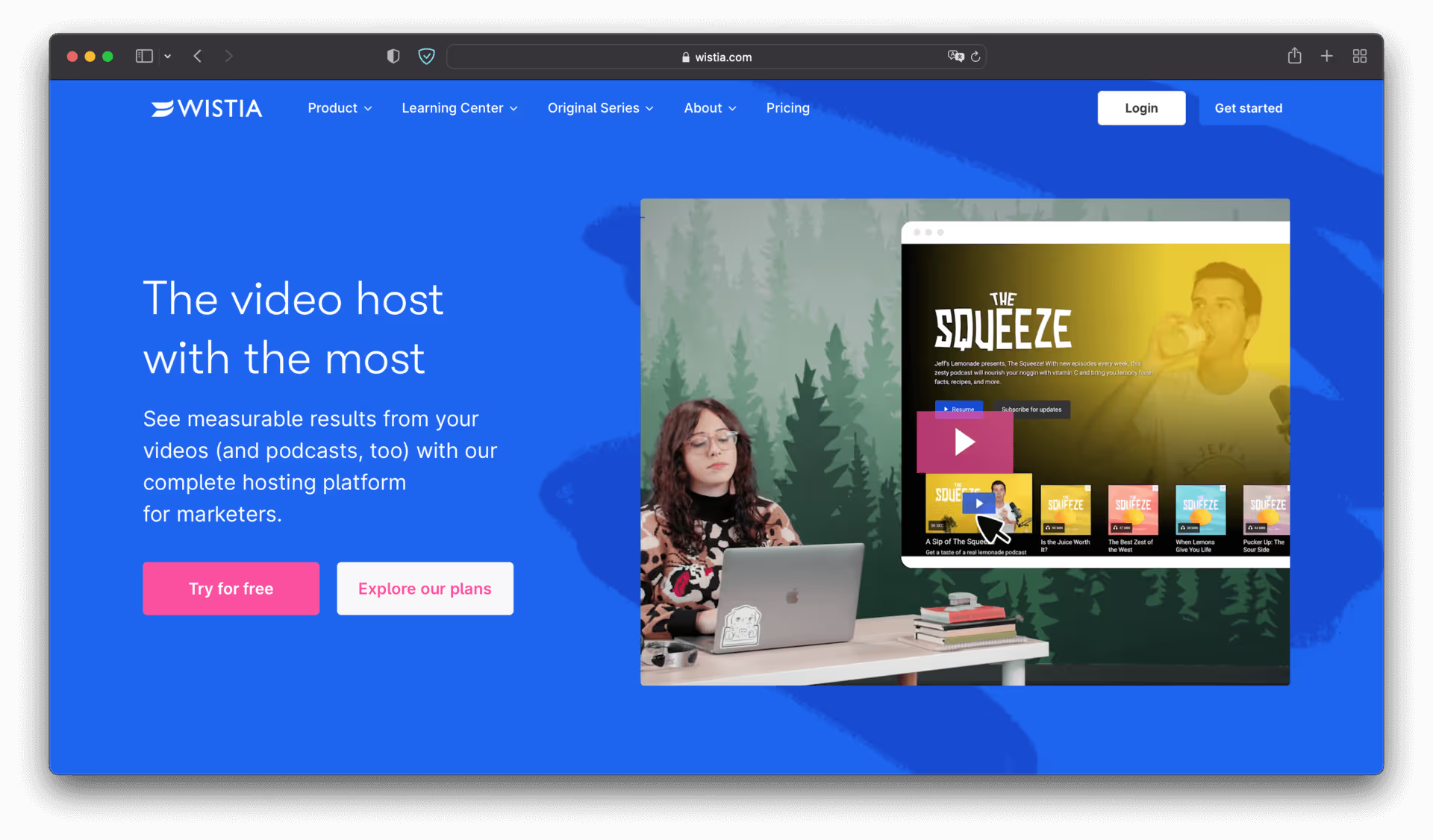
If you're looking for a professional video hosting tool to support your marketing strategy, Wistia is definitely worth considering. The US-based platform lets you create branded video channels and intentionally leaves out ads and video suggestions—so your audience stays focused on your content.
Standard features include:
- A fully customizable player
- Easy video embedding and sharing
- Unlimited user accounts
- Interactive video tools
- Simple integrations with tools like Mailchimp
- In-depth video analytics
After signing up, users can get started with a free account that includes:
- Uploads for up to three videos or podcasts
- One shareable channel via public Wistia link
- Up to 250 channel subscribers
- Wistia branding on the video player
- A/B testing
The Pro account, priced at $99/month, includes everything in the free plan plus:
- Uploads for up to ten videos or podcasts
- A public channel with up to 250 subscribers and email notifications
- Custom branding on the player
- A/B testing
- And for just $0.25/month per file, you can add as many additional videos or audio files as you like
3. Vidyard
Best for: Interactive sales videos.
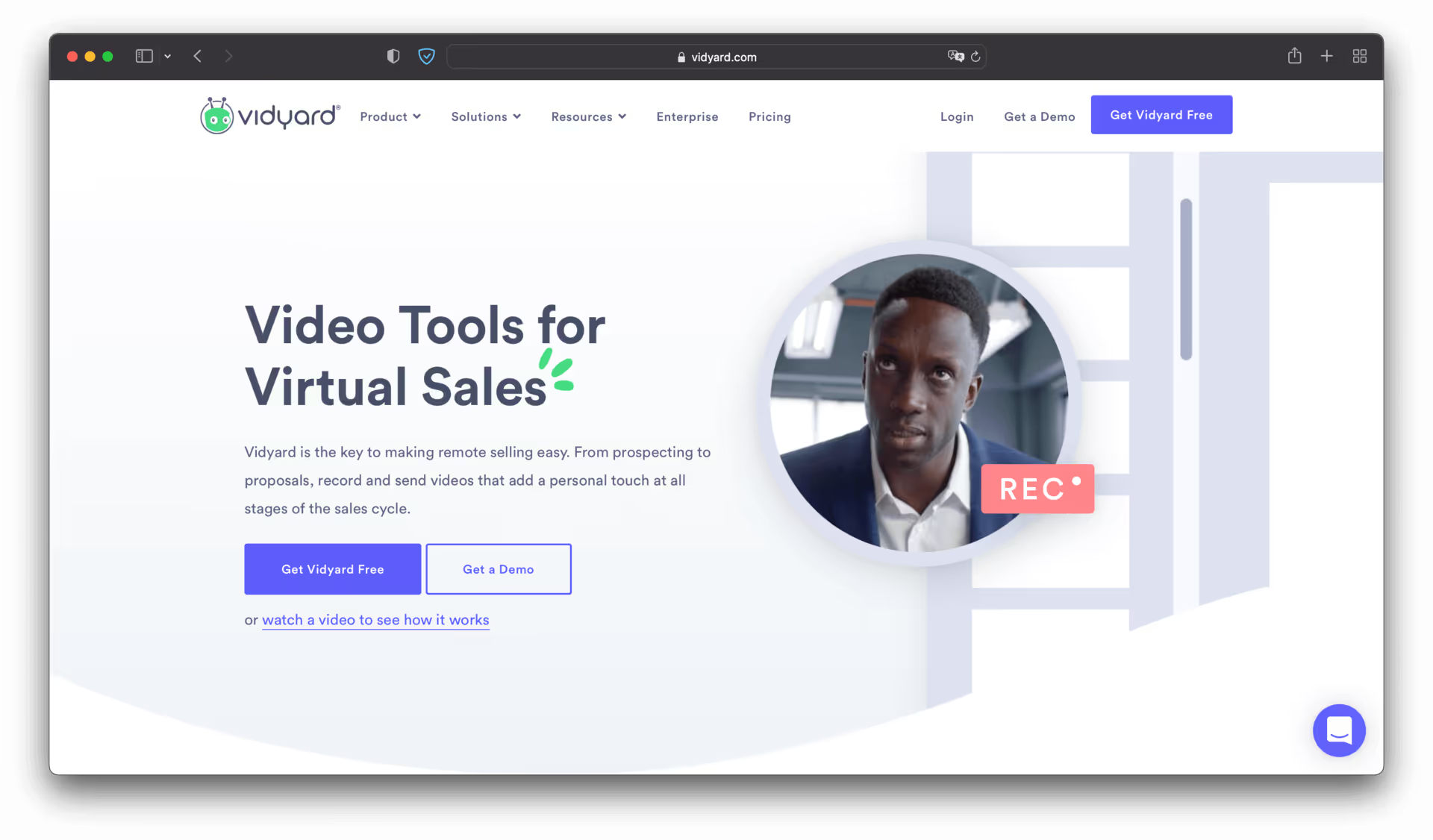
Vidyard is a video hosting provider based in Ontario, Canada—and it's especially appealing for sales teams that want to use video to strengthen their communication and boost conversion.
What sets Vidyard apart is its ability to deliver interactive, personalized video experiences, helping you make your messaging more direct and your brand more memorable.
Alongside a free plan, the platform offers three paid tiers with advanced features.
The free plan is ideal for individuals and includes:
- Unlimited video recording, uploading, and sharing
- Easy distribution via email, social media, and more
The Business plan is designed for larger teams and includes:
- $1,250 per month (billed annually)
- Minimum of five user accounts
- Access to the full feature set
- Customized video solutions with unlimited embedding, enterprise-grade security, API access, team controls, and more
- Top-level content protection and privacy features
4. Brightcove
Best for: Media companies with a global audience.

Brightcove, headquartered in Massachusetts, USA, stands out from the competition with its strong focus on video marketing support.
The platform targets marketers and publishers across industries like media and broadcast, arts and entertainment, sports, retail, and e-commerce.
If you want to explore Brightcove’s services, you can start with a free trial account. Custom pricing is available only upon request.
According to the company, Brightcove servers are located around the world, including in the United States. For users in the EU, Switzerland, and the UK, Brightcove provides specific privacy and data protection guidelines in line with the European Commission’s standard contractual clauses.
Key features of Brightcove include:
- Business-friendly CMS
- Advanced marketing automation integrations
- Real-time analytics
- Built-in video editing
- Engagement tracking
- Custom branding options
Designed primarily for enterprise-level use, Brightcove can be quite complex for small businesses or solo creators. Pricing typically starts at $199/month, with annual contracts required.
5. WordPress Video Hosting: Jetpack
Best for: Simple video management and embedding on your WordPress website
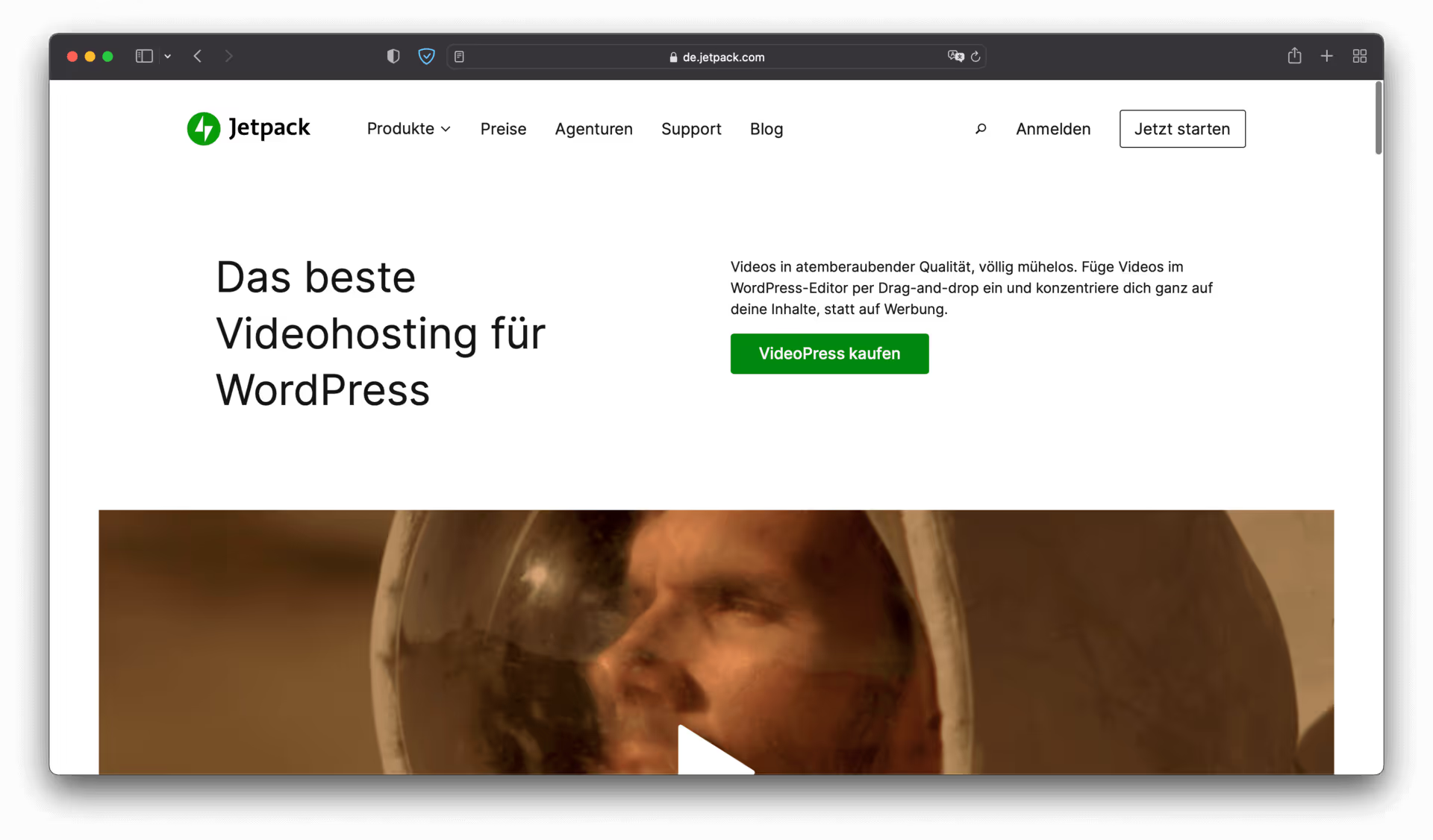
Jetpack is a premium video hosting plugin for WordPress that offers ad-free playback, 1 TB of storage, and unlimited user access for just €5.95 per month.
Key features include:
- Customizable video player that can be embedded unbranded into your site
- Video stats directly in your WordPress dashboard
- Playback settings like autoplay, mute, and loop
- Unlimited video uploads at a fixed price
- No advertising
- Full browser and device compatibility
While Jetpack provides good value for money, the feature set is fairly basic—especially when it comes to marketing. There are no built-in tools for lead generation or advanced video engagement.
6. SproutVideo
Best for: Video marketing directly on your own website.
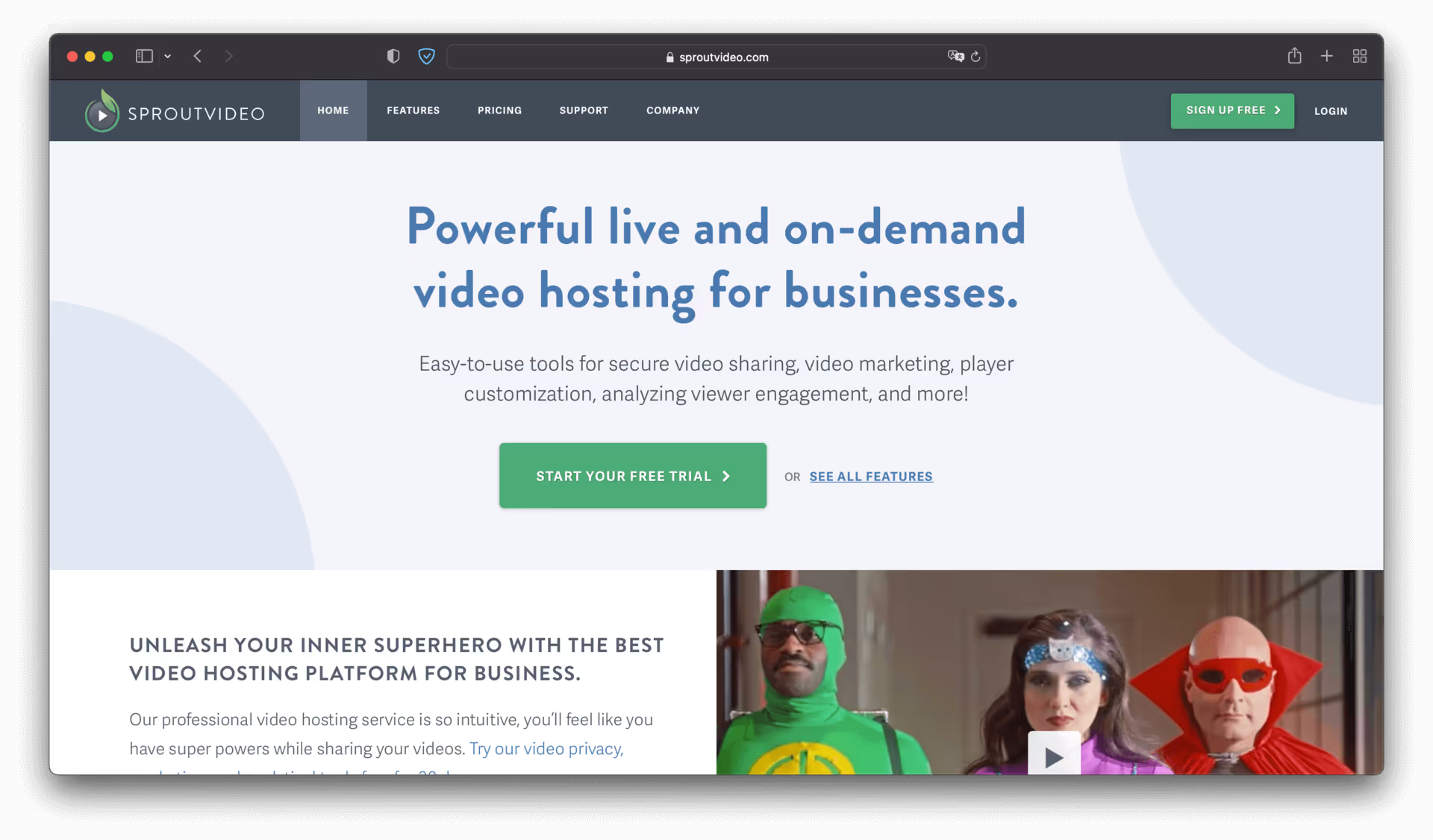
SproutVideo provides powerful tools to help businesses promote their videos—while also putting a strong focus on security and analytics.
According to the company, it hosts tens of millions of videos on its servers and delivers them across the globe. However, it’s unclear where exactly those servers are located.
SproutVideo offers several pricing tiers, all of which come with a free 30-day trial. You can upgrade, downgrade, or cancel at any time.
The entry-level plan, called “Seed,” starts at $24.99/month and includes:
- A powerful marketing suite
- Essential privacy tools
- A customizable video player
- API and JavaScript player API access
- Video analytics and engagement insights
- Email and live chat support
At the other end of the spectrum, the “Forest” plan is designed for enterprise use. Priced at $499.99/month, it includes all standard features plus:
- Single Sign-On (SSO)
- IP address restrictions
- Premium customer support
7. Swarmify
Best for: Speed-focused video applications.
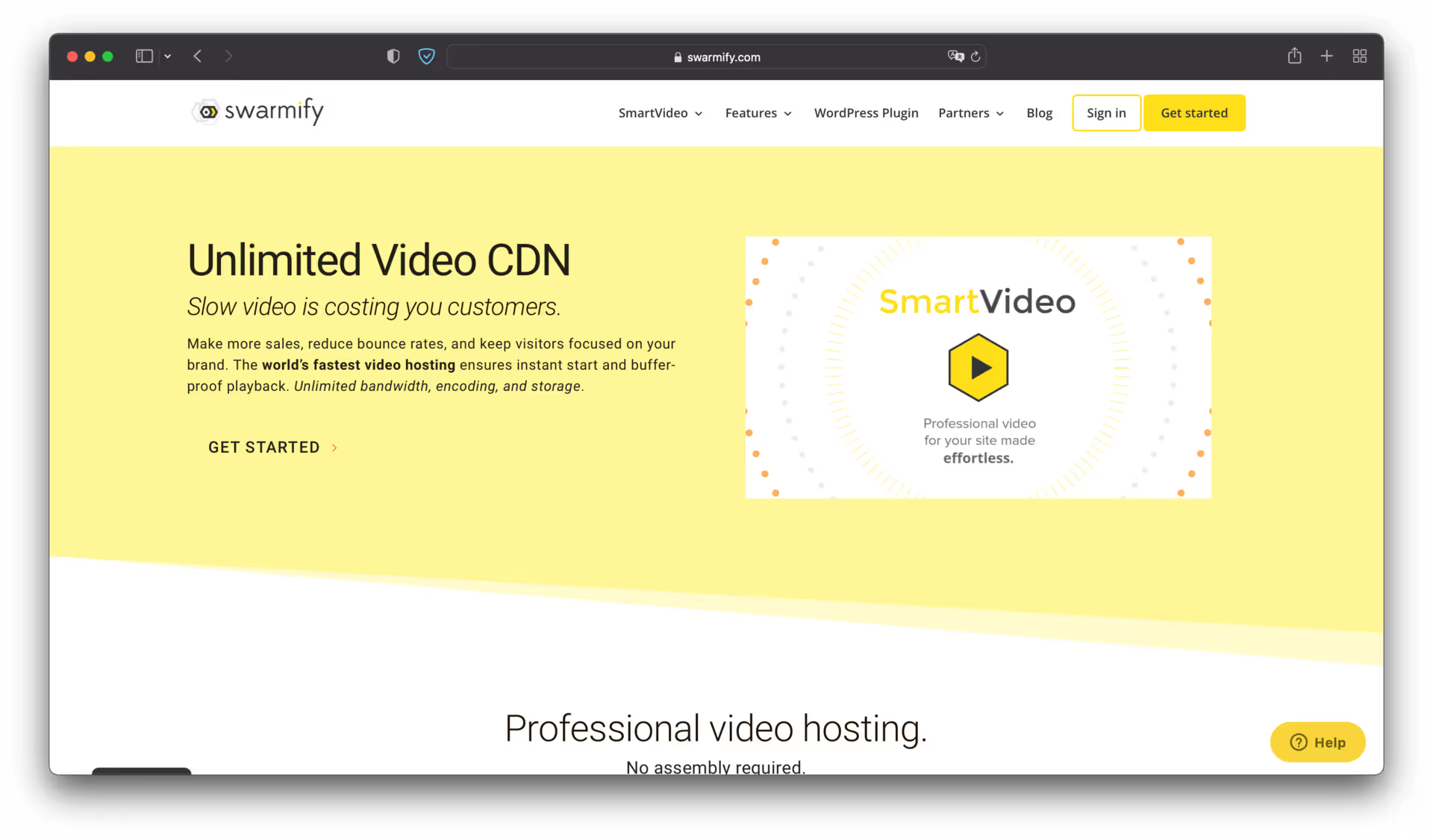
Swarmify is a US-based company that promotes itself as the fastest video hosting provider in the world.
Its video hosting solution uses a global Content Delivery Network (CDN) to accelerate content delivery while ensuring high availability and performance. One of its standout qualities is how easily it integrates into existing websites.
Key features include:
- SmartVideos that play without buffering
- Global CDN for fast, reliable playback
- Device-level encoding
- Color customization to match your corporate branding
- Unlimited bandwidth
- Real-time analytics
Pricing is straightforward and affordable:
- $59/month for the Small Business plan
- $119/month for the Video Pro plan
- Enterprise plans available upon request
8. Panopto
Best for: Educational institutions managing learning content, as well as large and mid-sized enterprises.

Panopto is a video hosting provider that offers regional cloud hosting options to ensure fast start times and minimal buffering—available across the US, Canada, the EU, and Asia.
Panopto’s key features include:
- API access for integrations
- Data loss protection via redundant storage and fail-safe recording
- Elastic scalability to maintain performance during peak loads
- Secure internal video hosting through a private video cloud
- Custom branding options
- Metadata management
- Embedding of YouTube videos, websites, and PDFs within recorded sessions
- Mobile app for on-the-go access
- Free trial available
The best free video hosting platforms
1. YouTube
Best for: Videos meant to reach a large community.

YouTube is the number one video platform on the internet. More than 500 hours of content are uploaded every minute, and users consume over one billion hours of video each day. Signing up is free, and there are no storage limits, so you can upload videos in the highest possible quality without worrying about quotas.
Embedding videos on your website is also straightforward, thanks to a variety of available tools. Once your channel gains traction, you can even generate ad revenue directly through the platform.
Key features of YouTube:
- Intuitive and easy to use
- By far the largest reach for video content
- Seamless integration with Google simplifies video SEO
However, there are some significant drawbacks for business users:
- Your videos are never shown in isolation—you have little control over how or where they appear.
- Unwanted ads may play before or after your video.
- Competing content may be suggested alongside or autoplay immediately after your own.
As a Google-owned platform, YouTube is a US-based service with data centers all over the world. That means a video viewed in Germany may not necessarily be streamed from within the country.
Although large data centers in Germany act as delivery points or temporary caches (as part of the Content Delivery Network), you have no influence over where your video files are ultimately stored. That makes YouTube a poor fit for sensitive corporate content, especially when GDPR compliance is required.
2. Facebook
Best for: Consumer brands looking to engage directly with their audience through video.
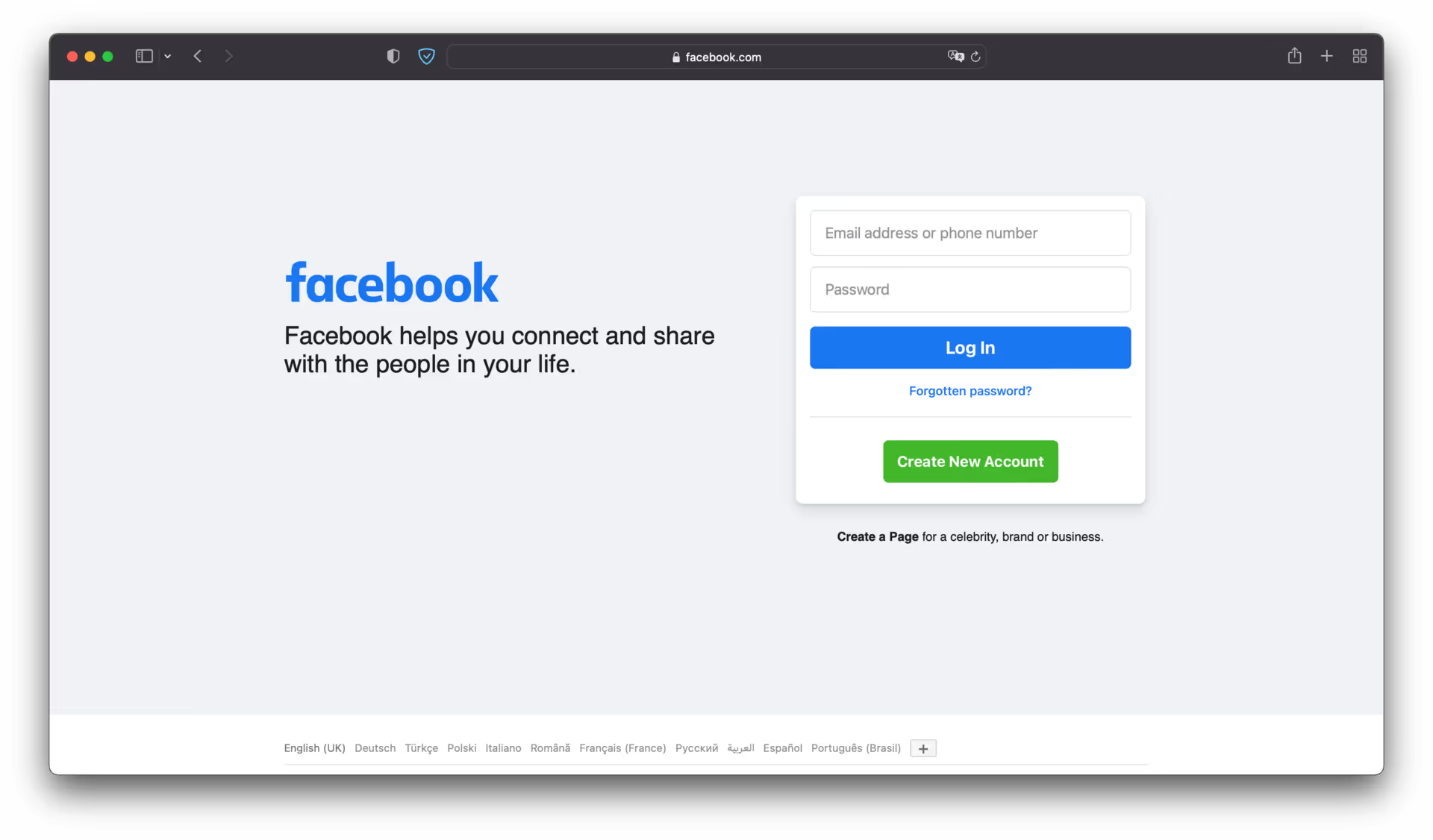
Every week, billions of videos are watched on Facebook alone.
With 2.9 billion monthly active users, Facebook remains one of the most visited social media platforms in the world. It allows businesses to upload videos in various formats, lengths, and resolutions with ease.
Key features of video hosting on Facebook:
- Unlimited video hosting
- Seamless video sharing directly on the platform
- The ability to build and engage with your own audience
That said, there are some important limitations:
- Ads may be automatically placed on all videos
- Video embedding is limited and less customizable compared to premium platforms
- Video quality can fall short—especially when compared to dedicated video hosting providers
While Facebook offers accessible video hosting with massive reach, the platform lacks flexibility when it comes to embedding videos on your own website and maintaining full control over the playback experience.
3. Vimeo
Best for: Videos that deserve to take center stage.

Vimeo—an anagram of the word movie—has been online since November 2004 and is available in multiple languages including German, English, Spanish, and Portuguese. The US-based platform introduced HD streaming in 2007 and added support for 4K Ultra HD in 2015.
While Vimeo offers a free basic plan, it also provides a range of paid options with more advanced features and storage.
Vimeo is particularly popular among content creators and creative professionals who want to showcase their videos in a high-quality environment. As a result, audience expectations on the platform tend to be higher.
In the free plan, you get:
- 500 MB of storage per week
- Up to 25 GB per year
That’s not much—especially considering that a 4K UHD video at 20 Mbps uses roughly 84 MB per minute.
Vimeo is headquartered in New York and operates servers in the US and other countries. Like YouTube, you have no control over where your videos are stored, and content may be processed on US-based infrastructure—something to consider when privacy or data protection is a concern.
Features worth noting:
- A tight-knit, constructive creator community
- Excellent video quality
- Statistics remain intact even when replacing a video with a newer version
- No disruptive ads—Vimeo is entirely ad-free
- Password protection is available even on the free plan
One limitation is audience size: Vimeo has far fewer users than YouTube. And although the base membership is free, every plan has storage limits, so scaling may require an upgrade.
4. Dailymotion
Best for: Videos that get lost in the noise on YouTube.
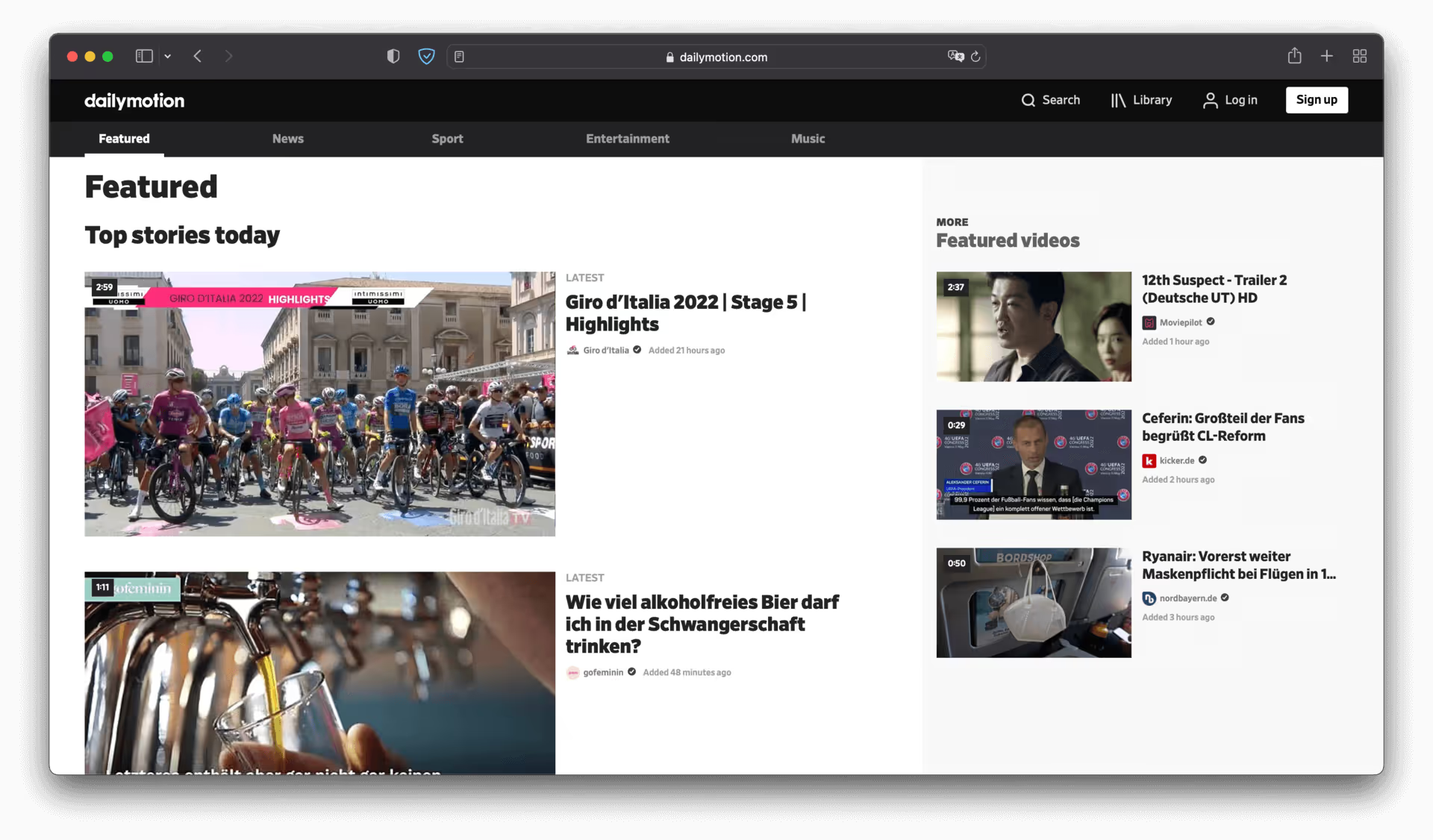
When it comes to video hosting, Dailymotion is quite similar to YouTube. The French platform allows you to host, store, manage, and monetize your videos, while also offering the ability to create a branded channel and grow a subscriber base.
Founded in 2005, Dailymotion is widely seen as YouTube’s largest competitor. Its modern, user-friendly interface lets visitors browse content by topic channels, tags, and groups.
Signing up is free, and the player is intuitive to use. Maximum video length is limited to one hour, but you can upload in 4K resolution with no strict quotas. WordPress plugins are available for easy website integration.
Dailymotion has offices in Paris, Barcelona, Athens, London, New York City, and Mumbai.
Key features of Dailymotion:
- A clean, easy-to-use platform for video hosting
- Smaller user base means less competition—no need to compete with 300,000 uploads per day like on YouTube
- Monetization is available once you reach sufficient viewership
However, there are some downsides:
- Server locations are not transparently disclosed
- Ads may be shown on your videos regardless of audience size or time of day, which can be disruptive
- Compared to YouTube, Dailymotion has significantly lower reach and upload limits, making it a less suitable choice for professional or large-scale video strategies
5. Twitch
Best for: Videos and livestreams aimed at a young, tech-savvy, gaming-oriented audience.
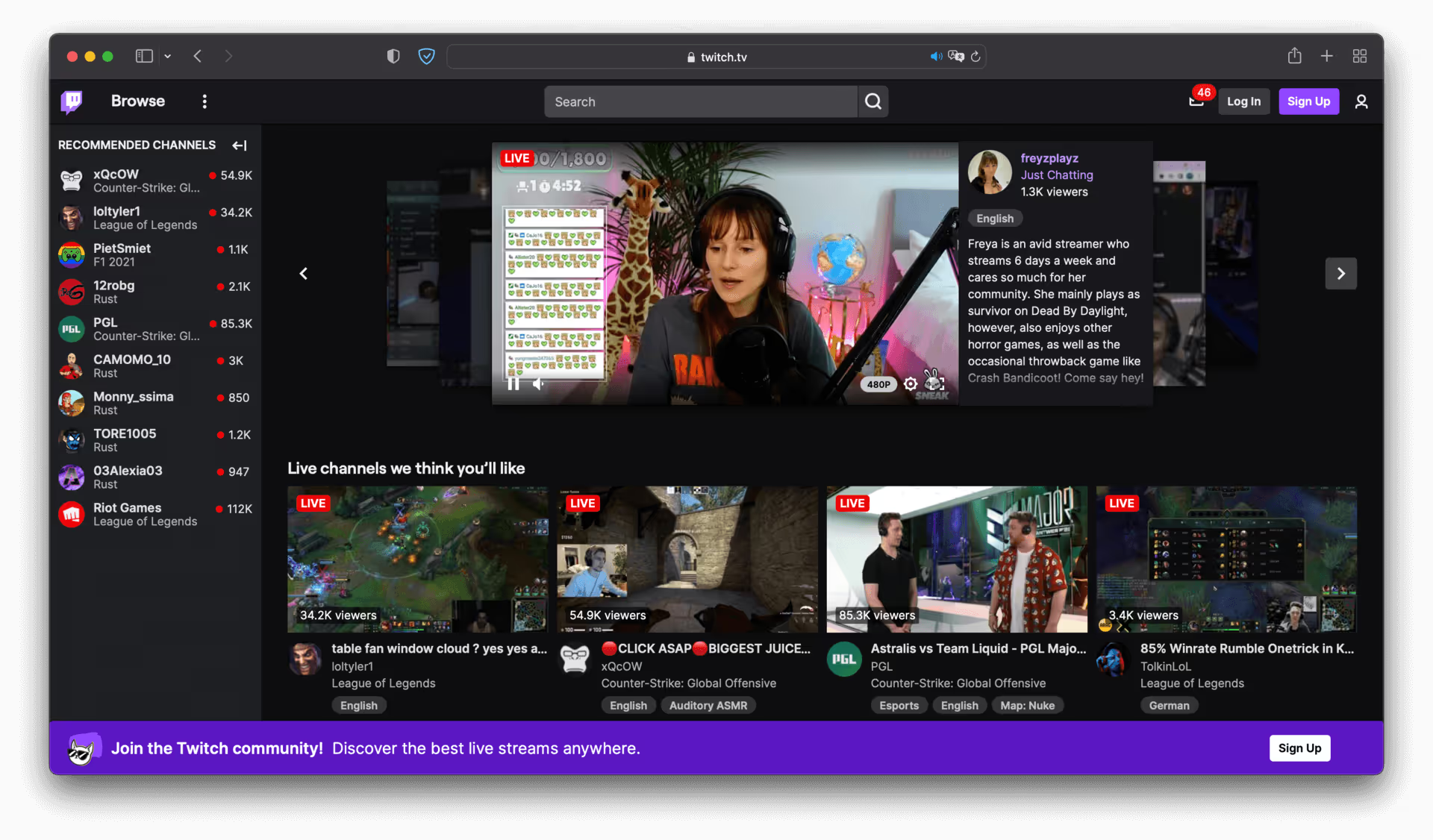
Twitch positions itself as a YouTube alternative tailored to gamers. The platform launched in beta in June 2011 and quickly grew—reaching around 45 million monthly viewers across more than six million channels within just two years.
Now owned by Amazon, Twitch offers a premium version called Twitch Prime, which includes ad-free streams, free channel subscriptions, bonus games, and in-game loot for Prime members.
While similar to YouTube in some respects, Twitch is primarily focused on live content. All users can access streams freely, and those who create a free account gain access to additional features like channel subscriptions, friend lists, chat functions, and the ability to stream their own content.
Though rooted in the gaming world, Twitch isn’t just for gamers. Its “IRL” (In Real Life) feature allows users to share personal video clips, and the platform also broadcasts professional esports tournaments and events.
To meet the demands of performance-conscious users, Twitch’s servers are globally distributed—including locations across the EU (e.g., Frankfurt, Amsterdam, London, Madrid, Lisbon, Paris, Stockholm), the US, and Asia.
Unlike YouTube, Twitch doesn’t focus on pre-recorded video libraries. Most of the content is streamed live, though short clips or highlights can be saved and accessed later by users.
Key features of Twitch:
- Strong focus on user-generated content
- Vibrant, interactive community
- Real-time audience engagement
However, access to monetization through the Affiliate and Partner programs is limited to creators who meet specific eligibility criteria. Many advanced features also require a Twitch Prime (Amazon Prime) membership or come with additional costs.
6. Spotlightr
Best for: Small video projects that need a professional touch.
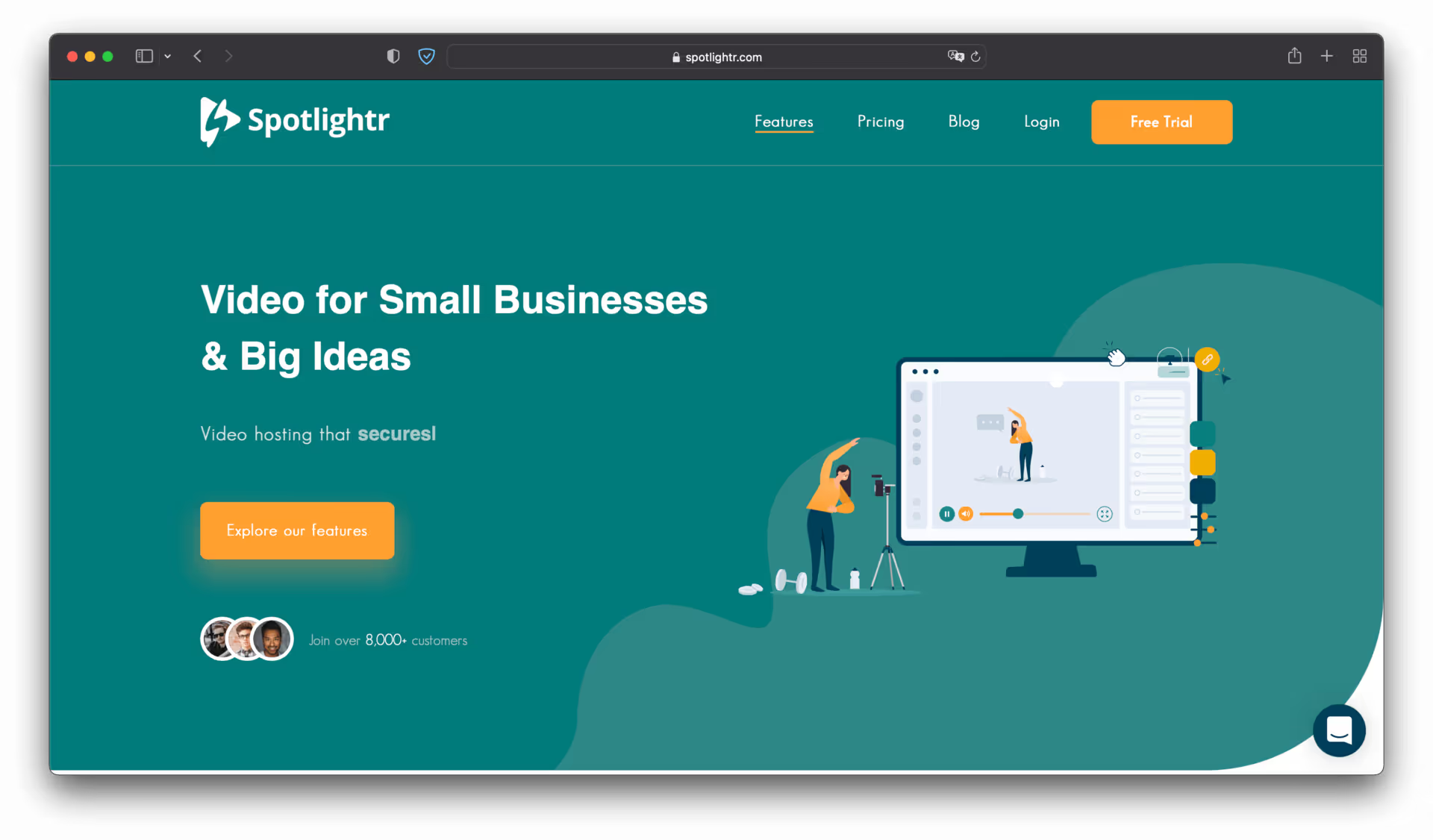
Spotlightr is designed to give small businesses a simple way to get started with professional video hosting. The US-based platform offers a free plan that includes up to 5 GB of storage and 5 GB/month of CDN bandwidth. The trade-off? You can host a maximum of 5 videos at a time.
Still, even the free version includes some useful features that make it easier to use video in a business context. You can share high-quality videos (up to 4K) without ads or distractions, and even play videos from platforms like YouTube or Vimeo ad-free in the Spotlightr player.
The free plan also includes basic marketing features, such as in-video call-to-action buttons and timed annotations. Basic analytics, including heatmaps and interaction graphs, are also available.
Spotlightr features at a glance:
- Built for small business needs
- Strong focus on marketing use cases
- A/B testing capabilities
- Cloud-based hosting
- Built-in social sharing
- Easy website embedding via auto-generated embed code
- Analytics dashboard
- Password protection
- Advanced HLS encryption
One important caveat: while Spotlightr offers advanced features, they can be overwhelming for beginners, and the free plan is quite limited in both scope and scale.
Why companies should choose a professional video hosting solution?
Full control, ad-free playback, custom security settings, centralized management, and seamless integration into existing systems—these are the most common expectations companies have when it comes to professional video hosting.
What’s driving these expectations? The ever-growing need for both internal and external communication through video. As the saying goes: a picture is worth a thousand words—but a video says even more.
Our surveys show that it’s not just customers who prefer content in video format. Employees, too, want more video-based communication across different use cases.
But there’s one critical factor that companies must consider: your videos are distributed and accessed worldwide. That creates high demands—not just for infrastructure, but also for compliance. Specifically, with regulations like the GDPR, which govern the handling of sensitive personal and business data.
That’s why professional video hosting platforms must offer more than just solid tech. They should provide:
- A comprehensive video CMS
- Role-based access control (RBAC)
- Flexible APIs
- Plugins and add-ons for smoother integrations
- Customizable player design
- Digital rights management (DRM)
- CDN and eCDN for reliable content delivery
- Automatic transcoding for optimized playback across devices and networks
Conclusion
Today, there are countless ways to host, manage, and share videos effectively. Choosing the right video hosting platform really comes down to what you want to achieve—and who you want to reach.
Many free video hosting platforms offer solid basic functionality and can be a great way to get started. However, they often come with trade-offs: ads, lack of control over placement, or limited data privacy protections.
Premium video hosting solutions—like our VideoManager Pro—are purpose-built for professional environments. They offer powerful features that enable centralized content management and smooth collaboration across teams and departments.
Data protection is also a key factor—especially for businesses in Europe. Meeting regulatory requirements like the GDPR is often a challenge with free or global platforms.
Get in touch with us today to learn why some of Germany’s largest enterprises, agencies, and corporations trust movingimage to host and manage their video content.
Our Speakers
How to choose the right video hosting platform
To store videos and make them easily accessible to your audience, uploading them to a video hosting platform is highly recommended. Sure, you could host videos on your own servers and embed them into your website or intranet—but that often leads to issues like network overload, long load times, and frustrated visitors.
A professional video hosting solution saves both you and your viewers from headaches and offers a host of powerful features that go far beyond what traditional embedding can provide.
Modern hosting providers support a wide range of video formats and automatically optimize playback to deliver the best possible video quality—while reducing your network load thanks to a Content Delivery Network (CDN). That’s not to mention built-in tools for SEO and social sharing.
But for companies, other factors come into play: Where are the servers located? What access rights can be granted to viewers and employees? How is the content protected? And how easily can the solution integrate with your existing systems?
To find the right provider, it's crucial to define your use cases and must-haves upfront.
In the next sections, we’ll walk you through the key features of various premium and free platforms.
The best premium video hosting providers
1. VideoManager Pro
Best for: Companies that need secure, centralized, GDPR-compliant video hosting for internal and external communications.

movingimage is the only provider on this list that hosts videos exclusively on servers located in the EU—ensuring full GDPR compliance, even for sensitive data.
As a German company, we understand the unique demands of large enterprises and agencies across the EU. With VideoManager Pro, we offer a powerful Video Content Management System (Video CMS) tailored to these needs, with AI features, RBAC (role-based access control), advanced privacy controls, and more.
One unique feature: you don’t pay for storage space, but for video duration—so you can always publish in the best possible quality without compromise.
Core features include:
- Role-based access control (RBAC)
- Customizable HTML5 video player
- Advanced transcoding
- Video analytics
- Copy protection
- SSL encryption
- IP-range filtering & geo-blocking
- Token authentication
- Auto-captioning
- Custom thumbnails
- Chapter markers
Starter Package includes:
- 500 video minutes (storage + transcoding)
- 500 GB CDN streaming traffic/month
2. Wistia
Best for: Videos that deliver a personalized experience in your marketing funnel.

If you're looking for a professional video hosting tool to support your marketing strategy, Wistia is definitely worth considering. The US-based platform lets you create branded video channels and intentionally leaves out ads and video suggestions—so your audience stays focused on your content.
Standard features include:
- A fully customizable player
- Easy video embedding and sharing
- Unlimited user accounts
- Interactive video tools
- Simple integrations with tools like Mailchimp
- In-depth video analytics
After signing up, users can get started with a free account that includes:
- Uploads for up to three videos or podcasts
- One shareable channel via public Wistia link
- Up to 250 channel subscribers
- Wistia branding on the video player
- A/B testing
The Pro account, priced at $99/month, includes everything in the free plan plus:
- Uploads for up to ten videos or podcasts
- A public channel with up to 250 subscribers and email notifications
- Custom branding on the player
- A/B testing
- And for just $0.25/month per file, you can add as many additional videos or audio files as you like
3. Vidyard
Best for: Interactive sales videos.

Vidyard is a video hosting provider based in Ontario, Canada—and it's especially appealing for sales teams that want to use video to strengthen their communication and boost conversion.
What sets Vidyard apart is its ability to deliver interactive, personalized video experiences, helping you make your messaging more direct and your brand more memorable.
Alongside a free plan, the platform offers three paid tiers with advanced features.
The free plan is ideal for individuals and includes:
- Unlimited video recording, uploading, and sharing
- Easy distribution via email, social media, and more
The Business plan is designed for larger teams and includes:
- $1,250 per month (billed annually)
- Minimum of five user accounts
- Access to the full feature set
- Customized video solutions with unlimited embedding, enterprise-grade security, API access, team controls, and more
- Top-level content protection and privacy features
4. Brightcove
Best for: Media companies with a global audience.

Brightcove, headquartered in Massachusetts, USA, stands out from the competition with its strong focus on video marketing support.
The platform targets marketers and publishers across industries like media and broadcast, arts and entertainment, sports, retail, and e-commerce.
If you want to explore Brightcove’s services, you can start with a free trial account. Custom pricing is available only upon request.
According to the company, Brightcove servers are located around the world, including in the United States. For users in the EU, Switzerland, and the UK, Brightcove provides specific privacy and data protection guidelines in line with the European Commission’s standard contractual clauses.
Key features of Brightcove include:
- Business-friendly CMS
- Advanced marketing automation integrations
- Real-time analytics
- Built-in video editing
- Engagement tracking
- Custom branding options
Designed primarily for enterprise-level use, Brightcove can be quite complex for small businesses or solo creators. Pricing typically starts at $199/month, with annual contracts required.
5. WordPress Video Hosting: Jetpack
Best for: Simple video management and embedding on your WordPress website

Jetpack is a premium video hosting plugin for WordPress that offers ad-free playback, 1 TB of storage, and unlimited user access for just €5.95 per month.
Key features include:
- Customizable video player that can be embedded unbranded into your site
- Video stats directly in your WordPress dashboard
- Playback settings like autoplay, mute, and loop
- Unlimited video uploads at a fixed price
- No advertising
- Full browser and device compatibility
While Jetpack provides good value for money, the feature set is fairly basic—especially when it comes to marketing. There are no built-in tools for lead generation or advanced video engagement.
6. SproutVideo
Best for: Video marketing directly on your own website.

SproutVideo provides powerful tools to help businesses promote their videos—while also putting a strong focus on security and analytics.
According to the company, it hosts tens of millions of videos on its servers and delivers them across the globe. However, it’s unclear where exactly those servers are located.
SproutVideo offers several pricing tiers, all of which come with a free 30-day trial. You can upgrade, downgrade, or cancel at any time.
The entry-level plan, called “Seed,” starts at $24.99/month and includes:
- A powerful marketing suite
- Essential privacy tools
- A customizable video player
- API and JavaScript player API access
- Video analytics and engagement insights
- Email and live chat support
At the other end of the spectrum, the “Forest” plan is designed for enterprise use. Priced at $499.99/month, it includes all standard features plus:
- Single Sign-On (SSO)
- IP address restrictions
- Premium customer support
7. Swarmify
Best for: Speed-focused video applications.

Swarmify is a US-based company that promotes itself as the fastest video hosting provider in the world.
Its video hosting solution uses a global Content Delivery Network (CDN) to accelerate content delivery while ensuring high availability and performance. One of its standout qualities is how easily it integrates into existing websites.
Key features include:
- SmartVideos that play without buffering
- Global CDN for fast, reliable playback
- Device-level encoding
- Color customization to match your corporate branding
- Unlimited bandwidth
- Real-time analytics
Pricing is straightforward and affordable:
- $59/month for the Small Business plan
- $119/month for the Video Pro plan
- Enterprise plans available upon request
8. Panopto
Best for: Educational institutions managing learning content, as well as large and mid-sized enterprises.

Panopto is a video hosting provider that offers regional cloud hosting options to ensure fast start times and minimal buffering—available across the US, Canada, the EU, and Asia.
Panopto’s key features include:
- API access for integrations
- Data loss protection via redundant storage and fail-safe recording
- Elastic scalability to maintain performance during peak loads
- Secure internal video hosting through a private video cloud
- Custom branding options
- Metadata management
- Embedding of YouTube videos, websites, and PDFs within recorded sessions
- Mobile app for on-the-go access
- Free trial available
The best free video hosting platforms
1. YouTube
Best for: Videos meant to reach a large community.

YouTube is the number one video platform on the internet. More than 500 hours of content are uploaded every minute, and users consume over one billion hours of video each day. Signing up is free, and there are no storage limits, so you can upload videos in the highest possible quality without worrying about quotas.
Embedding videos on your website is also straightforward, thanks to a variety of available tools. Once your channel gains traction, you can even generate ad revenue directly through the platform.
Key features of YouTube:
- Intuitive and easy to use
- By far the largest reach for video content
- Seamless integration with Google simplifies video SEO
However, there are some significant drawbacks for business users:
- Your videos are never shown in isolation—you have little control over how or where they appear.
- Unwanted ads may play before or after your video.
- Competing content may be suggested alongside or autoplay immediately after your own.
As a Google-owned platform, YouTube is a US-based service with data centers all over the world. That means a video viewed in Germany may not necessarily be streamed from within the country.
Although large data centers in Germany act as delivery points or temporary caches (as part of the Content Delivery Network), you have no influence over where your video files are ultimately stored. That makes YouTube a poor fit for sensitive corporate content, especially when GDPR compliance is required.
2. Facebook
Best for: Consumer brands looking to engage directly with their audience through video.

Every week, billions of videos are watched on Facebook alone.
With 2.9 billion monthly active users, Facebook remains one of the most visited social media platforms in the world. It allows businesses to upload videos in various formats, lengths, and resolutions with ease.
Key features of video hosting on Facebook:
- Unlimited video hosting
- Seamless video sharing directly on the platform
- The ability to build and engage with your own audience
That said, there are some important limitations:
- Ads may be automatically placed on all videos
- Video embedding is limited and less customizable compared to premium platforms
- Video quality can fall short—especially when compared to dedicated video hosting providers
While Facebook offers accessible video hosting with massive reach, the platform lacks flexibility when it comes to embedding videos on your own website and maintaining full control over the playback experience.
3. Vimeo
Best for: Videos that deserve to take center stage.

Vimeo—an anagram of the word movie—has been online since November 2004 and is available in multiple languages including German, English, Spanish, and Portuguese. The US-based platform introduced HD streaming in 2007 and added support for 4K Ultra HD in 2015.
While Vimeo offers a free basic plan, it also provides a range of paid options with more advanced features and storage.
Vimeo is particularly popular among content creators and creative professionals who want to showcase their videos in a high-quality environment. As a result, audience expectations on the platform tend to be higher.
In the free plan, you get:
- 500 MB of storage per week
- Up to 25 GB per year
That’s not much—especially considering that a 4K UHD video at 20 Mbps uses roughly 84 MB per minute.
Vimeo is headquartered in New York and operates servers in the US and other countries. Like YouTube, you have no control over where your videos are stored, and content may be processed on US-based infrastructure—something to consider when privacy or data protection is a concern.
Features worth noting:
- A tight-knit, constructive creator community
- Excellent video quality
- Statistics remain intact even when replacing a video with a newer version
- No disruptive ads—Vimeo is entirely ad-free
- Password protection is available even on the free plan
One limitation is audience size: Vimeo has far fewer users than YouTube. And although the base membership is free, every plan has storage limits, so scaling may require an upgrade.
4. Dailymotion
Best for: Videos that get lost in the noise on YouTube.

When it comes to video hosting, Dailymotion is quite similar to YouTube. The French platform allows you to host, store, manage, and monetize your videos, while also offering the ability to create a branded channel and grow a subscriber base.
Founded in 2005, Dailymotion is widely seen as YouTube’s largest competitor. Its modern, user-friendly interface lets visitors browse content by topic channels, tags, and groups.
Signing up is free, and the player is intuitive to use. Maximum video length is limited to one hour, but you can upload in 4K resolution with no strict quotas. WordPress plugins are available for easy website integration.
Dailymotion has offices in Paris, Barcelona, Athens, London, New York City, and Mumbai.
Key features of Dailymotion:
- A clean, easy-to-use platform for video hosting
- Smaller user base means less competition—no need to compete with 300,000 uploads per day like on YouTube
- Monetization is available once you reach sufficient viewership
However, there are some downsides:
- Server locations are not transparently disclosed
- Ads may be shown on your videos regardless of audience size or time of day, which can be disruptive
- Compared to YouTube, Dailymotion has significantly lower reach and upload limits, making it a less suitable choice for professional or large-scale video strategies
5. Twitch
Best for: Videos and livestreams aimed at a young, tech-savvy, gaming-oriented audience.

Twitch positions itself as a YouTube alternative tailored to gamers. The platform launched in beta in June 2011 and quickly grew—reaching around 45 million monthly viewers across more than six million channels within just two years.
Now owned by Amazon, Twitch offers a premium version called Twitch Prime, which includes ad-free streams, free channel subscriptions, bonus games, and in-game loot for Prime members.
While similar to YouTube in some respects, Twitch is primarily focused on live content. All users can access streams freely, and those who create a free account gain access to additional features like channel subscriptions, friend lists, chat functions, and the ability to stream their own content.
Though rooted in the gaming world, Twitch isn’t just for gamers. Its “IRL” (In Real Life) feature allows users to share personal video clips, and the platform also broadcasts professional esports tournaments and events.
To meet the demands of performance-conscious users, Twitch’s servers are globally distributed—including locations across the EU (e.g., Frankfurt, Amsterdam, London, Madrid, Lisbon, Paris, Stockholm), the US, and Asia.
Unlike YouTube, Twitch doesn’t focus on pre-recorded video libraries. Most of the content is streamed live, though short clips or highlights can be saved and accessed later by users.
Key features of Twitch:
- Strong focus on user-generated content
- Vibrant, interactive community
- Real-time audience engagement
However, access to monetization through the Affiliate and Partner programs is limited to creators who meet specific eligibility criteria. Many advanced features also require a Twitch Prime (Amazon Prime) membership or come with additional costs.
6. Spotlightr
Best for: Small video projects that need a professional touch.

Spotlightr is designed to give small businesses a simple way to get started with professional video hosting. The US-based platform offers a free plan that includes up to 5 GB of storage and 5 GB/month of CDN bandwidth. The trade-off? You can host a maximum of 5 videos at a time.
Still, even the free version includes some useful features that make it easier to use video in a business context. You can share high-quality videos (up to 4K) without ads or distractions, and even play videos from platforms like YouTube or Vimeo ad-free in the Spotlightr player.
The free plan also includes basic marketing features, such as in-video call-to-action buttons and timed annotations. Basic analytics, including heatmaps and interaction graphs, are also available.
Spotlightr features at a glance:
- Built for small business needs
- Strong focus on marketing use cases
- A/B testing capabilities
- Cloud-based hosting
- Built-in social sharing
- Easy website embedding via auto-generated embed code
- Analytics dashboard
- Password protection
- Advanced HLS encryption
One important caveat: while Spotlightr offers advanced features, they can be overwhelming for beginners, and the free plan is quite limited in both scope and scale.
Why companies should choose a professional video hosting solution?
Full control, ad-free playback, custom security settings, centralized management, and seamless integration into existing systems—these are the most common expectations companies have when it comes to professional video hosting.
What’s driving these expectations? The ever-growing need for both internal and external communication through video. As the saying goes: a picture is worth a thousand words—but a video says even more.
Our surveys show that it’s not just customers who prefer content in video format. Employees, too, want more video-based communication across different use cases.
But there’s one critical factor that companies must consider: your videos are distributed and accessed worldwide. That creates high demands—not just for infrastructure, but also for compliance. Specifically, with regulations like the GDPR, which govern the handling of sensitive personal and business data.
That’s why professional video hosting platforms must offer more than just solid tech. They should provide:
- A comprehensive video CMS
- Role-based access control (RBAC)
- Flexible APIs
- Plugins and add-ons for smoother integrations
- Customizable player design
- Digital rights management (DRM)
- CDN and eCDN for reliable content delivery
- Automatic transcoding for optimized playback across devices and networks
Conclusion
Today, there are countless ways to host, manage, and share videos effectively. Choosing the right video hosting platform really comes down to what you want to achieve—and who you want to reach.
Many free video hosting platforms offer solid basic functionality and can be a great way to get started. However, they often come with trade-offs: ads, lack of control over placement, or limited data privacy protections.
Premium video hosting solutions—like our VideoManager Pro—are purpose-built for professional environments. They offer powerful features that enable centralized content management and smooth collaboration across teams and departments.
Data protection is also a key factor—especially for businesses in Europe. Meeting regulatory requirements like the GDPR is often a challenge with free or global platforms.
Get in touch with us today to learn why some of Germany’s largest enterprises, agencies, and corporations trust movingimage to host and manage their video content.



.avif)


.avif)






.avif)

